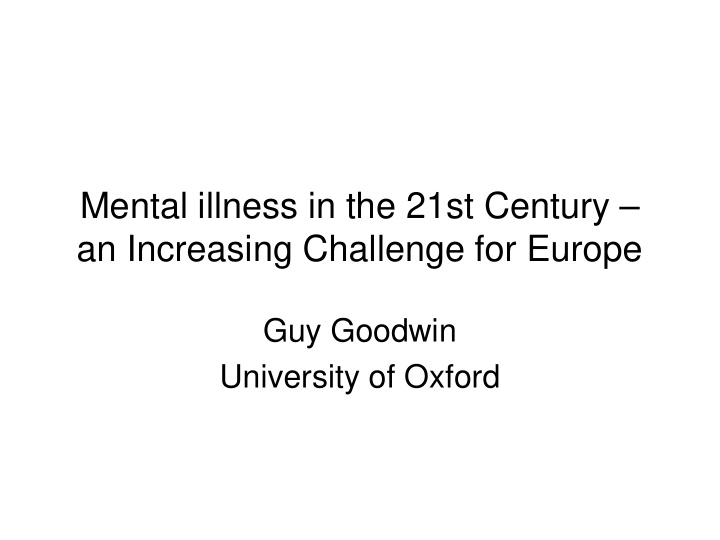



Mental illness in the 21st Century – an Increasing Challenge for Europe Guy Goodwin University of Oxford
The challenges • Mental disorders are common • Some of them, notably depression, are extremely costly both to the individual and society • Many patients do not receive treatment
ECNP/EBC Report 2011 Size and Burden of Mental Disorders and other Disorders of the Brain in Europe 2010 Hans-Ulrich Wittchen on behalf of the study group Institute of Clinical Psychology und Psychotherapy Center of Clinical Epidemiology and Longitudinal Studies (CELOS) Technische Universität Dresden , Germany This presentation summarizes and extends the findings reported in European Neuropsychopharmacology, 2011 (September issue)
Mental Disorders by prevalence (and estimated number of persons affected in millions) OCD 0.7 (2.9m) Eating disorder 0.9 (1.5m) Overall: Cannabis dependence 1.0 (1.4m) 164.8 milion of Health Disability Psychotic disorder 1.2 (5.0m) the total 510 Morbidity Personality dis. 1.3 (4.3m) million EU PTSD 2.0 (7.7m) population Conduct dis. 0.4% in total 3.0 (2.1m) Alcohol dependence 3.4 (14.6m) Somatoform disorders 4.9 (20.4m) ADHD/Hypercin. dis. 0,6% in total 5.0 (3.3m) Dementia 1.2% in total 5.4 (6.3m) Unipolar depression 6.9 (30.3m) Note: For many disorders, the 12-month Insomnia 7.0 (29.1m) prevalence refers to different ages ranges (like dementias to subjects Anxiety disorders 14.0 (29.1m) aged 60+). Thus the estimated number of persons refers to different 0 2 4 6 8 10 12 14 reference populations 12-month prevalence (no. persons affected)
Prevalence of mental health problems – working age population (UK) 100% 80% Symptom-free 64% 60% Severe mental illness (schizophrenia, bipolar disorder, 40% serious depression) 1%-2% Common mental disorders: 20% symptoms that reach threshold for diagnosis 17% 0% Symptoms (sleep problems, fatigue, worry, but no disorder 17%
Depression – costs for adults in England, 2000 - continued Total cost = £9 bn Productivity Mortality 90% 6% Service costs 4% Thomas & Morris Brit J Psychiatry 2003
GB - disability benefits, 2007 22% 6% € 3.9 billion per annum 18% Plus reduced tax receipts € 14 billion 40% 8% 6% Other Mental and Behavioural Disorders Nervous System Circulatory and Respiratory System Musculoskeletal System Injury, Poisoning, External Causes Department of Work and Pensions, 2007
Costs of health service use by diabetes patients, by depression severity 0 1 2 3 Number of reported diabetes complications 10000 8000 6000 4000 2000 0 1 2 0 3 0 1 2 3 1 2 3 0 No depression Subthreshold depression Major depression Simon et al, Gen Hosp Psychiatry, 2005
What to do? • Prevention and health promotion • Better access to treatment – Even if diagnosed, often not treated • Better treatment – Research – Development
New economic evidence on mental health promotion and mental illness prevention April 2011 Check report for full details http://www.dh.gov.uk/en/Publicationsandstatistics/Publications/PublicationsPolicyAndGuidance/DH_126085
Economic pay-offs per £1 Other Non- public public Total investment NHS sector sector Early identification and intervention as soon as mental disorder arises Early intervention for conduct disorder 1.08 1.78 5.03 7.89 Health visitor interventions to reduce postnatal 0.40 - 0.40 0.80 depression Early intervention for depression in diabetes 0.19 0 0.14 0.33 Early intervention for medically unexplained symptoms 1.01 0 0.74 1.75 Early diagnosis and treatment of depression at work 0.51 - 4.52 5.03 Early detection of psychosis 2.62 0.79 6.85 10.27 Early intervention in psychosis 9.68 0.27 8.02 17.97 Screening for alcohol misuse 2.24 0.93 8.57 11.75 Suicide training courses provided to all GPs 0.08 0.05 43.86 43.99 Suicide prevention through bridge safety barriers 1.75 1.31 51.39 54.45 Promotion of mental health and prevention of mental disorder Prevention of conduct disorder through social and 9.42 17.02 57.29 83.73 emotional learning programmes School-based interventions to reduce bullying 0 0 14.35 14.35 Workplace health promotion programmes - - 9.69 9.69 Addressing social determinants and consequences of mental disorder Debt advice services 0.34 0.58 2.63 3.55 Befriending for older adults 0.44 - - 0.44
Better treatment • Brain science – Make connections to clinical problems • Withdrawal of big pharma from neuroscience • Priority setting within the science budget at national and european level
ECNP A four point plan • Increase investment • Increase research • More rational regulations • Empower patients David Nutt and Guy Goodwin European Neuropsychopharmacology (2011) 21, 495–499 www.ecnp.e www.ecnp.e u
ECNP European research spend www.ecnp.e www.ecnp.e u
Conclusions • Mental disorders are common and disabling, affecting adults of working age • The costs are largely indirect – not services, drugs • Can we improve the delivery of effective treatments • How will we get innovation in prevention and treatment?
The Landmark discoveries • 1947 Lithium – Cade but developed by Schou etc • 1952 Chlorpromazine – Delay and Denniker • 1958 Imipramine – Kuhn • 1970 Clozapine • 1970 Zimelidine
The Landmark discoveries • Clinical trials • Meta-analysis of RCTs • Effective psychological treatments • Social psychiatry
Recommendations from the meeting Work on ways to increase investment . Enhance research . •Hosting a network for psychopharmacology research: ‘ the medicine chest ’ . •Developing ‘ open-source ’ databases for compounds that companies are no longer working to develop. This might include an ‘ eBay-like ’ option for other companies to bid for unwanted compounds. •Set up and/or recognise special centres of excellence in central nervous system (CNS) experimental research and brain imaging where sophisticated early phase trials can be conducted, experience accumulated, new researchers trained and skilled employment positions provided. •Work with US colleagues on initiatives in the same arena, such as the new National Institute of Health (NIH) translational medicine institute. •Create access to clinical trial databases to allow individual patient data meta- analyses to answer critical questions relevant to patient selection and trial design. Review the regulatory process Empower patients : work with patient organisations, particularly in relation to stigma, trial outcome measures and funding sources.
Recommend
More recommend